The forecasts for the domestic economy are underpinned by several technical assumptions. The exchange rate is assumed to remain around levels observed at the time of writing (a trade-weighted index of around 57 and a $US exchange rate of around 67c). Interest rates are assumed to decline broadly in line with market expectations, which suggest a cash rate of 2.5 per cent by May 2009. World oil prices (Tapis) are assumed to remain at around $US 50 per barrel. The farm sector forecasts are based on an assumed return to average seasonal conditions over the forecasting period, but take into account the effects of sustained drought conditions in the preceding period.
The new forecast year, 2010-11 takes into account the economic impact of the Government's Carbon Pollution Reduction Scheme due to commence in July 2010.
Household consumption
Households have been the beneficiaries of recent deep cuts to mortgage interest rates, cheaper fuel prices and additional payments from the Australian Government. The Economic Security Strategy and the Nation Building and Jobs Plan will together add around $19.7 billion to household incomes, principally in 2008-09, providing a significant but temporary boost to household consumption.
Nonetheless, the uncertainty around global financial conditions, combined with a forecast slowing in employment growth and sharply lower household wealth, are expected to weigh heavily on underlying household consumption growth in 2008-09 and 2009-10. The stock market is now around 50 per cent below its record high of late 2007, while median nominal house prices have fallen by around 3 per cent over 2008. The resulting declines in wealth are expected to focus households on increasing saving, with some recovery in the household saving ratio already apparent.
Household consumption is expected to grow by 1 per cent in 2008-09 before falling by ½ per cent in 2009-10 as the unwinding of the stimulus packages coincides with a weaker labour market. This would be the worst outcome on record and in part, reflects household's reaction to the largest through-the-year fall in real financial wealth on record. Household consumption is expected to recover in 2010-11 although remain below trend.
Chart 1: Real consumption with and without stimulus chart
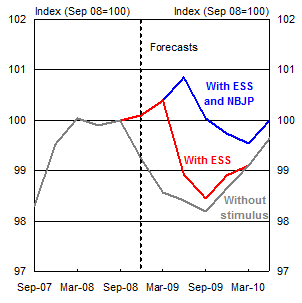
Source: ABS Catalogue Number 5206.0 and Treasury.
Chart 2: Household consumption and gross disposable income
(Real, Year average change)
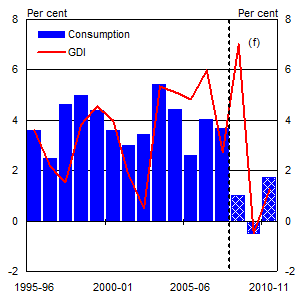
Source: ABS Catalogue Number 5206.0 and Treasury.
Chart 3: Household saving ratio
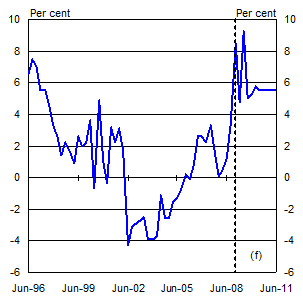
Source: ABS Catalogue Number 5206.0 and Treasury.
Dwelling investment
The near term outlook for the residential construction sector has deteriorated since UEFO, with data for housing finance and building approvals indicating a weaker starting point for any recovery in this sector. Total dwelling investment is now expected to be flat in 2009-10, down from the 4 per cent growth forecast at UEFO. Total dwelling investment is expected to grow by 10½ per cent in 2010-11, making a significant contribution to the economic recovery in that year.
Dwelling investment includes two components - the construction of new houses (new dwelling investment) and alterations and additions to existing homes. New dwelling investment is expected decline by 4 per cent in 2009-10, while investment in alterations and additions is expected to grow by 4 ½ per cent, supported by the Government's energy efficient homes program for housing insulation1. Significantly lower mortgage rates, combined with population growth and a continuation of reasonably high rental yields are expected to support investment during 2010-11.
Chart 4: Dwelling investment (real)
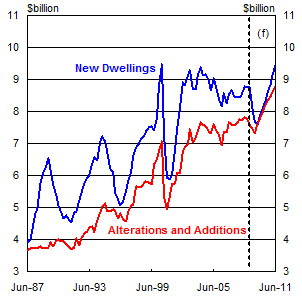
Source: ABS Catalogue Number 5206.0 and Treasury.
Slight falls in house prices have already been recorded in light of weakening demand, but the factors that are supporting investment activity and the First Home Owners Boost are also expected to support house prices at close to their current levels over the forecast horizon. There is a risk that house prices could slide by more than expected if consumer sentiment is further battered by bad news, such as rapidly rising unemployment. This would impact not only on forecasts for dwelling investment but also on the outlook for consumption and GDP growth.
Business investment
Momentum in new business investment is expected to help sustain a modest 2½ per cent growth rate in 2008-09. The impact of the global recession is expected to bite hardest in 2009-10, as firms cut back on investment activity in the face of tight credit conditions, plummeting global trade volumes, weaker commodity prices and weak domestic demand. Reflecting the deteriorating outlook, business sentiment has weakened further in recent months and all business surveys consistently show weaker investment intentions. Sharp falls in investment are expected in coming quarters and business investment is expected to decline by 19 per cent in 2009-10. This would be the largest annual decline on record and see business investment as a share of GDP falling from recent record highs to around pre-mining boom levels (Chart 4). A modest recovery in business investment of 3½ per cent is forecast for 2010 11.
Chart 5: Business investment to GDP ratio (nominal)
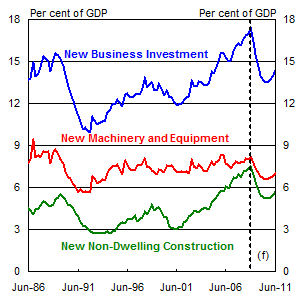
Source: ABS Catalogue Number 5206.0 and Treasury.
Investment in new machinery and equipment is expected to fall by 16½ per cent in 2009-10 with CAPEX investment intentions indicating particular weakness in manufacturing, construction and property and business services. In 2010-11, investment in new machinery and equipment is expected to grow by 4 per cent, as domestic and global demand strengthens.
New engineering construction investment is expected to fall by 14½ per cent in 2009-10. A rise of 5 per cent is expected in 2010-11, based on an expectation of a few high value projects in the oil and gas sector commencing work later in 2010.
Significant projects that are expected to commence in the forecast period include; Gorgon Joint Venture, Inpex Alpha LNG Ichthys, and Woodside LNG Browse. However, there remain significant downside risks to this forecast, with the possibility of further delays or cancelations to mining projects in light of falling commodity prices and to projects that are facing difficulty in securing financing.
A sharp fall of 38 per cent is expected in non-residential buildings investment in 2009-10 followed by a flat outlook in 2010-11. Recent approvals data for the sector have plummeted, with activity particularly affected by difficulties obtaining funding. Higher unemployment and a weaker consumption outlook are also expected to weigh on activity in the office and retail building sectors.
Chart 6: Private non-residential approvals
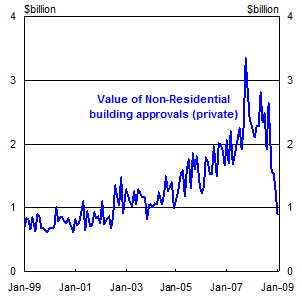
Source: ABS Catalogue Number 8731.0.
Public final demand
Growth in public demand is partially of
fsetting the significant weakness in private consumption and investment demand. Public final demand is forecast to grow by 4¾ per cent in 2008-09, 7½ per cent in 2009-10 and 1 ½ per cent in 2010-11.
The growth figures in 2009-10 and 2010-11 reflect the Nation Building and Jobs Plan and other infrastructure packages contributing around $23.5 billion to Commonwealth and State and Local government investment over the forecast period. As a consequence, public investment is expected to grow by 25½ per cent in 2009-10, the largest increase on record, driven principally by State and Local investment.
The huge boost to public spending will see public final demand increase sharply as a proportion of the nominal economy over the forecast horizon (Chart 7).
Given the importance of public final demand to GDP growth in 2009-10, the forecasts depend critically on public spending programs being implemented as announced. As such, there are significant risks around these forecasts, including slippage in spending by other jurisdictions and budget constraints on State governments.
Chart 7: Nominal public expenditure
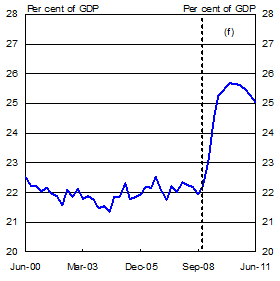
Source: ABS Catalogue Number 5206.0 and Treasury.
Exports, imports and the current account deficit
Since UEFO the global outlook has continued to deteriorate, which has resulted in further downward revisions to the forecasts of the external sector. The collapse in the global economy over the past few months has been dramatic, with the G7 in recession and demand in China showing clear signs of slowing sharply. The trade deficit is expected to increase sharply in 2009-10 as recent sharp falls in spot prices for commodities continue to flow through to negotiated contract prices. A widening in the trade deficit is expected in 2010-11, as domestic demand for imports strengthens ahead of a recovery in global demand.
Net exports are expected to contribute 1 percentage point to GDP growth in 2009-10 due to a significant fall in import volumes as the domestic economy weakens, and in response to the depreciation in the exchange rate. Net exports are expected to detract ¼ of a percentage point from growth in 2010-11 as import volumes recover more quickly than export volumes.
Export volumes are expected to be significantly weaker than at UEFO, falling by ½ per cent as global demand contracts. Modest growth of 5 per cent is expected in 2010-11, reflecting a recovery in the global economy.
Non-rural commodity volume growth is now expected to moderate to ½ per cent in 2008-09, remain flat in 2009-10, and recover strongly in 2010-11.
The collapse in global demand for steel and raw materials has been sudden and dramatic, and producers have sharply cut production. While such cuts have been substantial, in most cases they have been insufficient to prevent a substantial build in inventories. The only ray of hope has been China, where in some commodities (steel, iron ore and copper in particular), recent demand numbers have been surprisingly strong.
Nonetheless, it now appears that demand is unlikely to recover significantly until the beginning of 2010 at the earliest. While there is the potential for Chinese demand growth to surprise on the upside - owing to monetary and fiscal expansion measures - the key issues driving commodity markets in the short term are the scale of any further production cuts, and the timing of the end to current consumer destocking.
Chart 8: Import/Export contribution
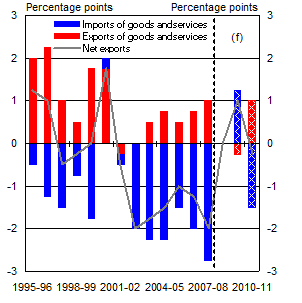
Source: ABS Catalogue Numbers 5206.0 , 5302.0 and Treasury.
Farm production is expected to increase by slightly more than at UEFO due to a larger winter crop. This is expected to flow through to rural exports, which, after solid growth in 2008-09, are expected to grow by 8 per cent in 2009-10 and remain flat in 2010-11. The main effect of the weaker world economy on rural exports is expected to be on prices, which are forecast to fall sharply.
Sharply lower world growth is expected to more than offset the boost from the recent depreciation in the exchange rate for elaborately transformed manufactures (ETM) and services exports. ETM exports are expected to contract by 6½ per cent in 2009-10, with a particularly acute decline for car exports, where the outlook has deteriorated rapidly following the sudden collapse in demand in key export markets, particularly the United States. Growth in services exports is forecast to fall by 3½ per cent in 2009-10. A moderate recovery in both ETMs and services is anticipated in 2010-11 as global demand strengthens.
Imports of goods and services are expected to fall by 2 percentage more than at UEFO, bringing the decline to 4¾ per cent in 2009-10. This largely reflects a weaker outlook for business investment which has a large imported component.
The terms of trade are forecast to decrease by 13¼ per cent in 2009-10, a slightly larger fall than at UEFO. Recent contract negotiations indicate that contract prices for the major bulk commodities are likely to fall in line with UEFO expectations. Other prices are expected to fall slightly more than UEFO, reflecting the weaker world outlook. The terms of trade are assumed to be flat in 2010-11, but the difficulty in forecasting commodity prices out this far means there remains the risk of further changes in commodity prices.
Chart 9: Terms of trade
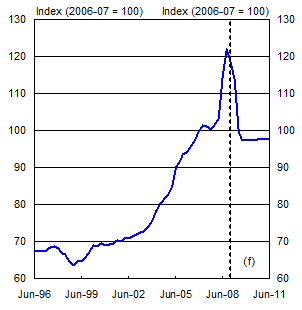
Source: ABS Catalogue Number 5302.0 and Treasury.
The current account deficit (CAD) is expected to widen to 5¾ per cent of GDP in 2009-10 and remain around this share in 2010-11. With the net income deficit (NID) now expected to remain broadly flat over the forecast horizon, changes in the trade balance drive the profile. From a savings and investment perspective, gross investment is forecast to decline as a share of GDP over the forecast horizon. Gross savings is forecast to rise in 2008-09 as households seek to rebuild savings, before declining in 2009-10 as corporate savings fall in line with reduced profitability. The public sector is expected to move into a significant deficit position.
Chart 10: Current account balance
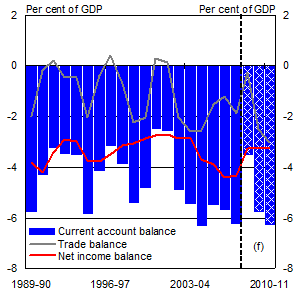
Source: ABS Catalogue Numbers 5206.0, 5302.0 and Treasury.
Employment, wages and inflation
Labour market
The outlook for the labour market has been downgraded further since UEFO, reflecting a significantly weaker outlook for the economy.
Employment is now expected to fall by 1 per cent through the year to the June quarter 2010, a full percentage point lower than forecast at UEFO.
Employment is then expected to gradually recover in 2010-11 as economic conditions begin to pick up, growing by ¾ of a per cent through the year to the June quarter 2011.
Chart 11: Employment Growth and Participation Rate
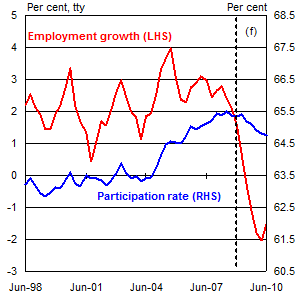
Source: ABS Catalogue Number 6202.0 and Treasury.
The unemployment rate is now expected to reach 8 per cent by June quarter 2010, peaking at 8¼ per cent in June quarter 2011.
The forecast unemployment rate for June quarter 2010 represents an upward revision of 1 percentage
point. The further rise in the unemployment rate in 2010-11 reflects an expectation that employment growth will remain below labour force growth for most of the year, given traditional lags between GDP growth and employment growth.
The participation rate has remained higher than expected over the past few months, supported by growth in part-time female employment, but the participation rate is expected to decline in line with a deteriorating jobs market, as potential job seekers become discouraged by rising unemployment. The participation rate is forecast to fall steadily across the forecast horizon, reaching 64½ per cent by the June quarter 2011, a fall of 1 percentage point from its high of the June quarter 2008.
Prices and Wages
Wages
Wages growth is expected to moderate in line with the weakness in domestic demand and rising unemployment. The tightness seen in the labour market over the last few years has eased as businesses become reluctant to hire new workers in view of the slowdown in the economy. It will take some time for the broader weakness in the economy to be reflected in wages, with recent outcomes remaining strong.
Growth in the WPI is expected to ease to 3¼ per cent through the year to the June quarter 2010 and remain around this rate over the forecast horizon.
Prices
Inflation forecasts have been revised down further since UEFO, driven by weakening demand and an anticipated weak labour market over the forecast period. Both headline and underlying inflation are forecast to ease over the forecast period. In the absence of the CPRS, both headline and underlying inflation would be expected to be 1½ per cent through 2009-10 and 2010-11.
Chart 12: Headline Consumer Price Index
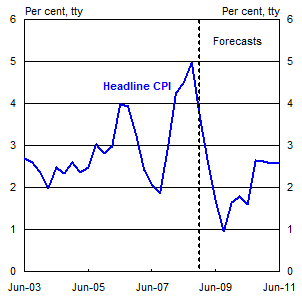
Source: ABS Catalogue Number 6401.0 and Treasury.
The introduction of the CPRS in July 2010 is expected to provide a one off increase in prices of around 1.1 per cent in 2010-11, bringing the CPI through the year to June 2011 to 2½ per cent.
1 This spending was included as expenditure by States and local authorities in the UEFO forecasts but has been subsequently reclassified as renovation spending by households.